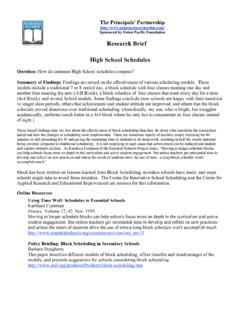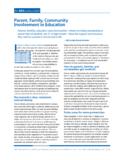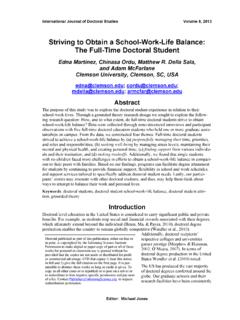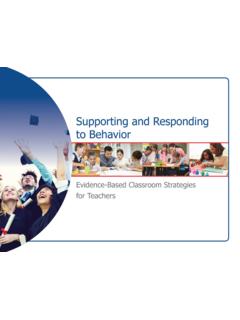Transcription of Encouraging Quality in Early Childhood Education …
1 1 Encouraging Quality in Early Childhood Education and Care (ECEC) research brief : WORKING CONDITIONS MATTER What are working conditions ? Working conditions in ECEC settings are often referred to as structural Quality indicators ( , wages, staff-child ratio, maximum group size, working hours, etc.) and other characteristics ( , non-financial benefits, team-work, manager s leadership, workload, etc.) that can influence the ability of professionals to do their work well and their satisfaction with the workplace, work tasks and nature of the job.
2 What is at stake? Attracting, training and retaining suitably qualified ECEC staff is a challenge. Good working conditions are strong incentives for qualified staff to enter the profession. Structural Quality indicators have received ample attention because they can usually be regulated or guided at the national level. For staff Quality , it is also crucial that practitioners are motivated and supported in applying what they have learned. The European Commission s Early Matters symposium (European Commission, 2009) concluded that many research findings indicate that, in addition to training and Education of staff, staff working conditions are important in providing safe, healthy and good learning environments for children.
3 In spite of these findings, the ECEC sector is usually associated with relatively poor working conditions and poor compensation leading to high turnover rates. ECEC centres often experience turnover rates exceeding 40% annually, undermining the Quality of care (Moon and Burbank, 2004). Why do working conditions in ECEC matter? research points out that the ability of staff to attend to the needs of children is influenced not only by their level of Education and training but also by external factors, such as their work environment, salary and work benefits (Shonkoff and Philips, 2000).
4 Working conditions can have an impact on staff job satisfaction and their ability to carry out their tasks; and their possibilities to positively interact with children, give them enough attention and stimulate their development. Strongly associated with stable, sensitive and stimulating interactions with children are the context and conditions in which staff member works. One study found that low wages: i) effect the ways in which staff interact with children, and ii) are related to high turnover rates (Huntsman, 2008). High turnover rates can have a negative effect on ECEC Quality since staff provision is less stable, which, in turn, can impact child development.
5 When staff members regularly change within a group of children, staff and children are less able to develop stable relationships; and nurturing, stimulating interactions take place less often (CCl, 2006). The body of research on the effects of working conditions on child development is not very extensive, and findings do not always point in the same direction. This is mainly because there is a complex inter-relationship between staff-child ratios, staff qualifications, Quality and type of provision that makes it difficult to single out the effect of a particular characteristic of working conditions (Sammons, 2010).
6 2 What matters most? Firstly, it is important to point out that more research is needed in this area. Available research findings focus on the effects on staff satisfaction rather than on child development. Many aspects of working conditions are found to be related to the Quality of ECEC services, while a few aspects have been found to be related to child development. Table 1 presents an overview of research findings, pointing to characteristics of working conditions that matter. Table 1. Which staff working conditions improve ECEC?
7 Optimal staff working conditions Areas of improvement ECEC services Child outcomes 1. High staff-child ratio and low group size X X 2. Competitive wages and benefits X unclear 3. Reasonable schedule/workload X unclear 4. Low staff turnover X X 5. Stimulating and playful physical environment X unclear 6. Competent and supportive centre manager X unclear Note: Areas of improvement that remain unclear present important opportunities for future ECEC research . Source: Ackerman, 2006; Burchinal et al., 2002; De Schipper et al., 2004; De Schipper et al.
8 , 2006; De Schipper et al., 2007; Diamond and Powell, 2011; Huntsman, 2008; Litjens and Taguma, 2010; Loeb et al., 2004; Moon and Burbank, 2004; Sheridan and Shuster, 2001; Sheridan et al., 2009; Torquati et al., 2007. Staff-child ratio Higher staff-child ratios, referring to a smaller number of children per staff, are usually found to enhance ECEC Quality and facilitate better developmental outcomes for children (Burchinal et al., 2002, De Schipper et al., 2006; Huntsman, 2008; Torquati et al., 2007). While there have been some older studies with contradictory results, the weight of evidence favours the conclusion that staff-child ratio in an ECEC setting is significantly associated with Quality (Huntsman, 2008).
9 Findings on Quality can be summarised as follows. Better staff-child interactions and less stress for staff Larger staff-child ratios are associated with better working conditions and less stress. Staff are found to be more supportive when they are responsible for a smaller group of children (De Schipper et al., 2006). A higher staff-child ratio improves working conditions within ECEC settings, as staff can give sufficient attention to different developmental domains and create more caring and meaningful interactions with children. As the number of children per staff member increases, staff spend more time in restrictive and routine communication with children and less in positive verbal interactions (Litjens and Taguma, 2010; Rao et al.)
10 , 2003). Better child development Children become more co-operative in activities and interactions with larger staff-child ratios. They also tend to perform better in cognitive and linguistic assessments when staff-child ratios are higher. Furthermore, academic development seems to be enhanced by higher staff-child ratios, although there are not many (recent) studies that have investigated this topic (Huntsman, 2008; Sylva et al., 2004). A limitation of the research mentioned above is that most findings are almost exclusively correlational and there have been very few experimental studies (Huntsman, 2008).


















